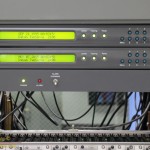Time… It is simply a matter of time. At 00:00UT May 3rd, many of the observatory computers suddenly started reporting that the date was September 17th, 1995. To say that this created some problems is a dramatic understatement.

The problem came from the primary observatory clock. This clock, properly called a time server, uses GPS signals to create a time reference that is accurate to microseconds. This is made possible by referencing to the atomic clocks carried by each GPS satellite. A time server is intricately connected to the network to distribute this time. Any computer in the building can ask it for time via the NTP protocol, but that has some inaccuracy due to network delays. For equipment requiring more precise time the server distributes a hard wired time reference using the IRIG-B protocol or a 1PPS timing pulse.
Without accurate time a telescope will simply not point in the correct direction. The calculation that the computers perform must take into account our rotating planet. Feed incorrect time to that calculation and you will point to the wrong piece of sky. A few milliseconds off can result in a pointing error of arcseconds, a large error for a large telescope.
